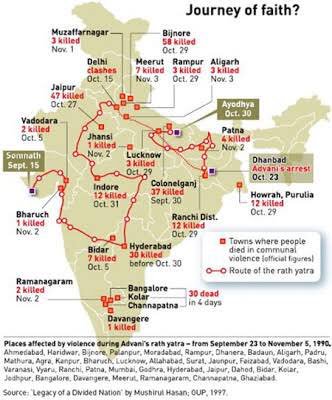The Indian Express, November 1, 2021
India’s electoral democracy and the Hindutva chalk circle
Badri Narayan writes: Political parties may be either in the soft or hard Hindutva fold, but everyone needs to demonstrate their Hindutva affiliation. This has become clear in the run-up to UP elections.
Written by Badri Narayan
In the game of electoral democracy in India, one now has to play within a chalk circle. This is the chalk circle of Hindutva, which is defined by right-wing ideologues as “Hinduness”. It is drawn by those engaged in inculcating and strengthening the Hindutva consciousness among people. Within this circle, one may be either in the soft or hard Hindutva fold, but everyone needs to demonstrate his or her Hindutva affiliation, either by visiting temples, chanting the Durga Path or promising to support the work going on for the development of Hindu pilgrimage sites. One can see this trend in the run-up to the Uttar Pradesh assembly election, where Hindutva has emerged as one of the dominant political ingredients.
At a recent rally in Lucknow, on the occasion of Kanshi Ram’s 15th death anniversary, BSP chief Mayawati promised not to derail the ongoing work of the BJP government in the three holy cities of Ayodhya, Varanasi and Mathura, should her party come to power. During the recent Kisan Nyay Yatra, Priyanka Gandhi, Congress general secretary and in-charge of UP, chanted the Durga Path and the jayghosh of “Har Har Mahadev”. She also recited from the Gurbani and the Quran, to demonstrate the ethos of sarva dharma sambhav in her political appearance. However, the chants of Durga Path and the sound of “Har Har Mahadev” echoed louder in the rally. Until Rajiv Gandhi’s regime, it had been part of Congress’s political culture for leaders to visit temples, mathas and religious peethas. But during his tenure, the pressure of retaining Muslim votes made the Congress defensive and the performances of Hindu religious symbolism became comparatively weak in its political mobilisations and strategies. Now, due to pressure from the Hindutva chalk circle, the Congress is trying to become louder while narrating its relation with Hindu religious symbols.
Akhilesh Yadav, leader of the Samajwadi Party, also understands the rules of the electoral games set by UP’s Hindutva politics. He visited Ayodhya, Chitrakoot and Vimalnath temple in Farrukhabad to assert his Hindu identity. Arvind Kejriwal who is working to expand to UP, recently visited Hanuman Garhi of Ayodhya and prayed to Ram Lalla at the Ram Janmabhoomi temple site. He also announced the inclusion of Ayodhya in Delhi’s free pilgrimage scheme for senior citizens.
All political parties are now required to enter the chalk circle of Hindutva because they all want to create socio-political alliances with as many castes as possible in order to win the elections. Most of them have realised that their core voter base alone can’t provide a majority. They need to extend their caste-based chalk circle and, of course, religious identity provides more opportunities and generates more forms of relationships with different castes, communities and people. Secondly, Hindutva politics, led by political parties such as the BJP, mobilised broader social groups of Hindus in the previous elections and diluted the pressure of minority votes, proving that demonstrating their Hindutva affiliation can be politically beneficial now.
But what the opposition politicians miss is that the chalk circle of Hindutva is drawn by organisations like the Rashtriya Swayamsevak Sangh (RSS), which evolved not only by symbolic acts but by its decades-long hard work at the grassroots. The organisation’s seva karya (social service) during natural calamities and other crises, their educational and health-based projects, and developmental schemes have successfully helped them forge close ties with various communities.
Yet, with all political parties offering Hindutva as a prominent part of their political package for the coming election, the question arises: How will they forge a close connection with the Hindu mind and engage with the Hindutva bhaav, which has become more expressive in recent decades? The opposition parties who are contesting the UP election may be able to respond in terms of the symbolic aspect of religious identity, but it is difficult to say right now whether they have the capacity to respond to the substantial aspect of the same, which requires organising the popular religious consciousness with grassroots work, through a strong network of cadres and religion-based organisations. When the symbolic aspects combine with the substantial aspects, there are effective results, otherwise, it is a mere performance.
This column first appeared in the print edition on November 1, 2021 under the title ‘The Hindutva chalk circle’. The writer is a professor at the G B Pant Social Science Institute and author of Republic of Hindutva


